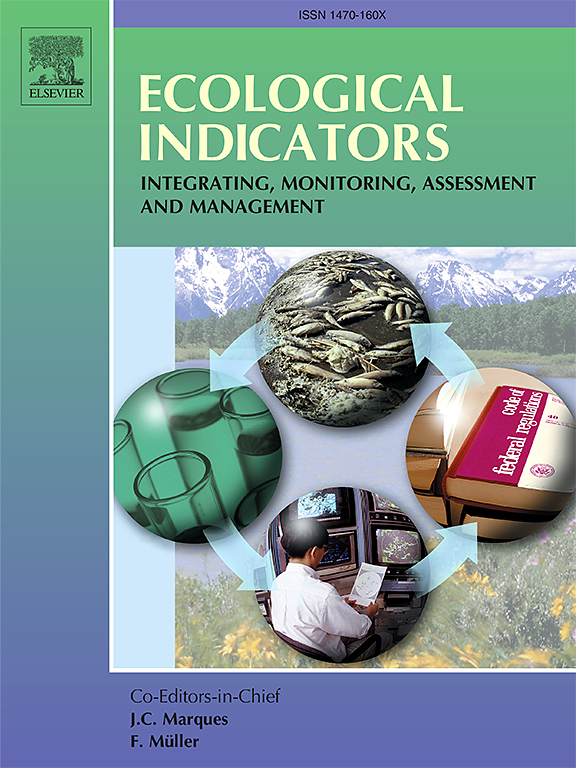Study on assessment of water system health in Heihe River Basin based on the game theory
IF 7
2区 环境科学与生态学
Q1 ENVIRONMENTAL SCIENCES
引用次数: 0
Abstract
Maintaining river health holds significant implications for guaranteeing the proper functioning of water systems and promoting social development. The construction and restoration of the river environment has emerged as a hot issue, and conducting an assessment study of water system health plays a crucial role in quantitatively describing water system health problems and providing a basis for related governance activities. Taking the Heihe River Basin in Gansu Province as the study area, this study conducts an assessment based on the Index System Method. By combining Game Theory Combinatorial Weighting Method, “Punishment-Incentive Variable Weight Model”, and the Fuzzy Matter-Element Extension Method, a comprehensive assessment process with scientific accuracy and high applicability to the “environment + management” situation of regional environmental conditions is established. In addition, satellite remote sensing technology is introduced, utilizing Sentinel-2 satellite remote sensing imagery in combination with linear fitting, curve fitting, and algorithm fitting to establish regional models for water quality indicators. Modelling and assessment calculation process to form a study system for evaluating and governing the health of the water system in the Heihe River Basin in Gansu Province. The study presents multi-indicator inversion models for watershed water quality, with XGBoost showing the best performance. Model accuracies (R2) for TN, pH, Chl-a, and Tur exceed 0.7. Preliminary analyses using the above ideas suggest that the current basin water system is most likely to be in a “health” condition, and it is noted that regional management prioritizes water system connectivity and biological resource protection.and that this study system can subsequently provide guidance for local long-term construction and management.
基于博弈论的黑河流域水系统健康评价研究
保持河流健康对保障水系正常运行、促进社会发展具有重要意义。河流环境建设与修复已成为热点问题,开展水系健康评估研究对于定量描述水系健康问题、为相关治理活动提供依据具有重要作用。本研究以甘肃省黑河流域为研究区域,采用指标体系法进行评估。结合博弈论组合权重法、"惩罚-激励变量权重模型 "和模糊物元扩展法,针对区域环境状况的 "环境+管理 "现状,建立了科学准确、适用性强的综合评估流程。此外,还引入卫星遥感技术,利用哨兵-2 卫星遥感图像,结合线性拟合、曲线拟合、算法拟合等方法,建立区域水质指标模型。通过建模和评估计算过程,形成甘肃省黑河流域水系健康评价与治理研究体系。研究提出了流域水质的多指标反演模型,其中 XGBoost 的性能最佳。TN、pH、Chl-a 和 Tur 的模型精度(R2)超过 0.7。利用上述思路进行的初步分析表明,当前流域水系最有可能处于 "健康 "状态,并指出区域管理应优先考虑水系连通性和生物资源保护。
本文章由计算机程序翻译,如有差异,请以英文原文为准。
求助全文
约1分钟内获得全文
求助全文
来源期刊

Ecological Indicators
环境科学-环境科学
CiteScore
11.80
自引率
8.70%
发文量
1163
审稿时长
78 days
期刊介绍:
The ultimate aim of Ecological Indicators is to integrate the monitoring and assessment of ecological and environmental indicators with management practices. The journal provides a forum for the discussion of the applied scientific development and review of traditional indicator approaches as well as for theoretical, modelling and quantitative applications such as index development. Research into the following areas will be published.
• All aspects of ecological and environmental indicators and indices.
• New indicators, and new approaches and methods for indicator development, testing and use.
• Development and modelling of indices, e.g. application of indicator suites across multiple scales and resources.
• Analysis and research of resource, system- and scale-specific indicators.
• Methods for integration of social and other valuation metrics for the production of scientifically rigorous and politically-relevant assessments using indicator-based monitoring and assessment programs.
• How research indicators can be transformed into direct application for management purposes.
• Broader assessment objectives and methods, e.g. biodiversity, biological integrity, and sustainability, through the use of indicators.
• Resource-specific indicators such as landscape, agroecosystems, forests, wetlands, etc.
 求助内容:
求助内容: 应助结果提醒方式:
应助结果提醒方式:


